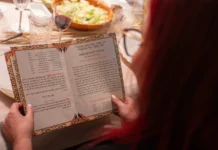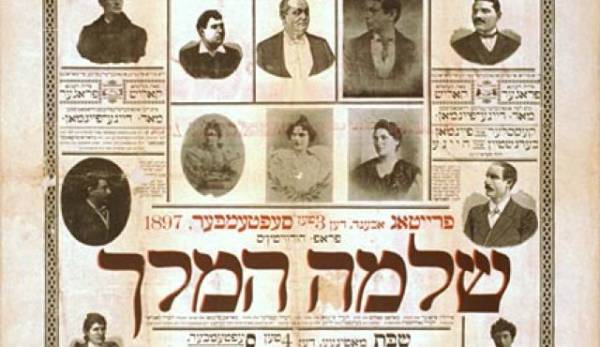 Moshe Ish HaLevy was born on 27 February in Stanislawow, Eastern Galicia to an orthodox family who were followers of the Gaon Hshl”kh. He studied with Rabbi Meshulam Horowitz and later in a house of study. At fifteen years of age he began to learn the job of the religious slaughterer. After this he became involved with the Haskalah and with secular studies. At the age of eighteen he moved to Iasi, Romania, where he became a Hebrew teacher. In 1871 he issued both in Hebrew and Romanian a newspaper which didn’t continue for too long.
Moshe Ish HaLevy was born on 27 February in Stanislawow, Eastern Galicia to an orthodox family who were followers of the Gaon Hshl”kh. He studied with Rabbi Meshulam Horowitz and later in a house of study. At fifteen years of age he began to learn the job of the religious slaughterer. After this he became involved with the Haskalah and with secular studies. At the age of eighteen he moved to Iasi, Romania, where he became a Hebrew teacher. In 1871 he issued both in Hebrew and Romanian a newspaper which didn’t continue for too long.
He moved to Bucharest where, as he assured us, became a professor of geography in the local university. At that time he undertook the task to translate the Bible into Romanian. We are certain that Horowitz became the director of a Jewish school in Bucharest. When the leaders of the school fired him, Horowitz converted and became a missionary.
Abraham Goldfaden tells us: After Passover in 1877, just after the Yiddish theatre had barely survived the first winter in Bucharest, Israel Gradner came to me for an interview and told me a secret. He said that there was a man who had a new play that he wanted to give to me. He wanted me to stage it. He introduced me to this person, and I gave him a date and time when he should come to my home in order to read his play to me. Two days later Gradner brought this man to my home where he read a three-act piece to me called “Dos poylishe yingl (The Polish Youth).” From the start I came to the conclusion that this might be the immortal masterpiece of the world famous satirist Yitzhak Yoel Linetzky — but no, I was wrong.
This was a sort of stupid vaudeville show in three acts, “The Art of a Shmendrik” (a fool). In those days I might have staged it. The truth is that the secret which the author shared with me forbid me to use this piece.
The secret was that the author of this piece was a missionary, and he was well known in Bucharest as such. To my question as to why he did this, the missionary/author answered, telling me that he had fallen upon bad times. He said that he and his family were existing on potato skins. That’s how bad things had become for him. He couldn’t earn any more from his position as a school director. Since his newfound God had offered him ninety francs a month, he had no choice but to accept the job, as he himself could plainly see. I could not take on this play to stage it at the opening of a brand new Yiddish theatre. The audience should not be able to say that the theatre had converted too.
“He could see that I was correct in this assumption. None the less the missionary left me in an angry mood. He swore vengeance upon me. … He didn’t take long to think about this, and he asked for amnesty and two days later he entered a tavern and called for a quorum of coachmen. He then asked for three barrels of wine to be brought out and openly converted back to Judaism. He gave a sermon at that time in which he declared: Just as your grandfather ‘Terah’ (The patriarch Abraham’s father) also served foreign gods, and the Jews accepted his son Abraham as a sincere Jew, so too could his descendants be Jewish, and without having any fear that this would be held against them. As a sign that his words were exceptional, he wanted that from then on he should be call ‘Moshe ish Horowitz HaLevy (Moses, son of the man Horowitz the Levite)’. … He convinced the local bartender who had a vacant courtyard to let him build a stage there. He, Horowitz would pay him a goodly sum every night from his intake. He also assured him that he could make more from the theatre than he would from the tavern. He said that this would more than compensate him for his empty bar. He also convinced him that he would sell much more beer to his audience because he (Horowitz) will announce on his posters that everyone that buys a ticket to his theatre will give him for free a glass of beer. In this way he managed to convince the tavern keeper, Hanina, to give up a certain sum of money upfront which he (Horowitz) would need for other expenses; the tin to make the lanterns would cost so much per night, the painter who will paint the decorations would also charge so much per night. He mathematically told him how much joy he should expect to make. He also promised him that he would not take any money for himself that first night. He said that he was working to earn credit in the next world … ”
According to the theatrical announcements in the Bucharest newspapers “The Yiddish Telegraph” which appears in Sh.’s novel which is quoted in the “History of the Yiddish Theatre and Drama,” we can see that Horowitz opened his theatre after 24 April 1877.

Horowitz put together a new troupe including his daughter Charlotta, Cesar Greenberg (later his son-in-law), and others, most of whom would not remain working on the stage for too long. He also rehired Abba Shoengold, and they all went out to play the provinces. In Barlad, a new actress joined them. This was Chaya Sora, or Clara whom Shoengold married. After wandering around for a long time throughout Romania with the actors: Greenberg, Spicer, Bergman and his wife, Axelrod, Feivele Friedman et al, Horowitz then went to Galicia, where according to B. Gorin he and his daughter Charlotta and his son-in-law [Cesar] Greenberg joined up with Gradner’s company, which was comprised of Gradner and his wife, Weinblatt, Eskreyz, Lennard (sp), Hermanel etc. At first they played in the larger Galician towns and in Romania, where he staged (according to Blank) his play “Eliyahu,” and after that (12 July 1882) they performed in the Ring Theatre in Vienna. The Yiddish actors received no great honors from the public, and the troupe fell apart. After a short visit to Odessa where he performed as an actor in Shomer’s “Dos protsentnik (The Usurer),” Horowitz returned back to Galicia and joined an established troupe: Greenberg and his wife, Axelrod, Kalmen Juvelier and his wife (Yetta Deitch), and Yetta Samuilov (later known as Schorr). Shortly afterwards he went to Budapest, where he used up the money that his employees gave him to guard. He was arrested but ran away very soon thereafter to Constantinople, and from there to London. He arrived approximately there in 1886. After a short period of time he traveled to America.
In New York they were staging his play, “Tisa eslar,” (music by Mogulesko. The role of Dr. Edvish was played by the author), which he wrote while he was still in Romania.
M. Seifert who attended the opening night of the play wrote: “Overall this play had very little literary worth since the historical facts that occur in it were, by and large, false and taken out of the clouds. However, the play was a box-office success. The reasons for their success was that, first of all, the cast performed very well, and secondly the music was excellent (here Seifert claims that the composer was not Mogulesko, but Gabriel Finkelstein.) Thirdly the events surrounding Tisa Eslar’s blood libel were still fresh (A young girl in Hungary was beheaded. The Jews were accused of using her blood for making matzo, and as a result a pogrom erupted).”
Ab. Cahan wrote about the presentation: “Professor Horowitz played the accused man, and it was very apparent that he not only spoke from a written script, but that he was talking directly to us. For three-quarters of an hour he spoke, and he managed to leave out nothing. He spoke in ‘Deitshmerish’ (Germanized Yiddish). At the next performance he gave an altogether different lecture.”
B. Gorin wrote about this: “This was the one and only play on the Yiddish stage that was accompanied by a serialized talk that was not scripted (the play in the first of the series was called, “Tisa Eslar, or, the Oath,” a play in five acts and fifteen scenes. The second of the series was “Der protzes fun tisa eslar (The Tisa Eslar Trial),” in four acts and twelve scenes.”
In “Tisa Eslar” Horowitz wanted to create a great sensation, a drama that would grab everyone’s attention. The libel of Tisa Eslar at that time was fresh in the minds of everyone. Every Jew was interested in this libel. This was a true-to-life issue. The success of this play showed him that with such material it was possible to interest the public. So that when a national catastrophe, or a national misfortune arose, he took advantage of it to stage a drama.”
Jacob Mestel tells us that in 1913 he saw in Pomul Verde in Iasi (directed by Ashkenazi and Leresko) where they performed the play “Tisa Eslar.” This time the play was performed in an abridged format (a one-evening play and not as a series). It had great box-office success.
Horowitz’s second play was “Shloyme hamelekh, oder, Di libe oys shir hashirim, in 5 akts, 15 bilder mit prolog un epilog” (King Solomon, or, The Love from the Song of Songs, in five acts, fifteen scenes with a prologue and an epilogue). With this play there began — according to B. Gorin — the most important aspect of the plays that Horowitz ever provided for the Yiddish stage: a “historical operetta.” This play was once again a great success. Due to the competition between the two Yiddish theatres at that time in New York, the second theatre presented a similar play “Mishpat shloyme (Solomon’s Judgment),” by the well-established dramatist Joseph Latayner.
M. Zeifert, who attended the opening night, wrote: “After ‘Tisa Eslar’ they presented an opera at the Roumanian Opera House, “Shloyme hamelekh (King Solomon).” This play had a great success, mainly because on the music, rather than the content of the opera itself, which resembled the book “M’gurat Ha’m’aut (The Lamppost)” and could not be compared to a cheap novel. The composer Horowitz Halevy in “Shloyme hamelekh” dragged into the second act, as if yanked by the hair, the historic drama “Balthazar,” which had no connection to the play.”
After “Shloyme hamelekh,” which they presented in the Roumanian Opera House in 1887, they staged Horowitz’s “Yehuda un yisroel, oder, Shma Yisroel, historische operetta in 4 aktn (Judah and Israel, or, Hear O Israel),” a historic operetta in four acts. Some portions of this play were translated, and others were reworked from the German play, “Di tzvey serjshantn (The Two Sergeants).”
In the same year (1887), and at the same theatre, they staged Horowitz’s “Don yosef abarbanel (Don Josef Abarbanel),” in four acts (music by Gabriel Finkelstein), which Horowitz — according to B. Gorin -took from Katzaboi’s play (a play that Horowitz wrote because the competitive theatre was playing Reuben Weismann’s play, “Don Yitzhak Abarbanel.”
About “Don Josef Abarbanel, Zeifert wrote: “Finklestein and Mogulesko wrote wonderful music, but it was not successful. It was somewhat flat, but yet full of good rhymes such as “Make me a summer guest.” The character Abarbanel does not appear in this play. What it does have is a somewhat crazy character who roams aimlessly around the stage. He was half-Cossack and a third Indian. “Professor” Horowitz, with much argument, donned a small prayer shawl on him. He instructed him to scream out, “I am Abarbanel!”
“In that same year (1887) — M. Zeifert wrote — In the “Roumanian Opera House,” they staged a new play by Horowitz Halevy called “Shabse Zvi” (the false messiah in Turkey in the seventeenth century). Though the name was of no importance and certainly had nothing to do with the subject of the play, we must say it was one of the best comedies in the Yiddish theatrical repertoire. As far as we know, this was the one and only original play that Horowitz Halevy ever wrote. (According to B. Gorin this was a liberal adaptation of Aaron Halle-Wolfsohn’s “Liechtzin und Fremelay” (Frivolity and Abandonment). In this play we find true Jewish types and character presented with great talent. This was an honest depiction of Chasidic life.
The play did not succeed because at that time they hadn’t nurtured an audience that could appreciate it. The audiences at that time looked only for a cynical couplet, a little dance and over-the-top decorations. All this was lacking in the play ‘Shabse Zvi.’ In it we could find a great deal of Talmudic humor. But the audience did not understand it. … A few years later Horowitz reworked it completely (perhaps he even destroyed it altogether). From La Donje’s play, ‘Mayn Leopold (My Leopold),’ they removed the character of the music teacher as though with nails. He then pieced him into his new play ‘Shabse Zvi.’ ”
The competition between the theatres indicated both theatres were struggling. The hatred that one theatre had for the other — Gorin wrote — grew bigger and bigger. The more hatred they expressed, the sharper it grew. The theatres were not satisfied that one had stolen a play, or the contents of a play from the other. The bitter competition between them was beyond repair. The directors of the two theatres put out posters in which they made bitter accusations about the other. The best output of each theatre was to discredit the other. Aside from the posters they gave talks from the stage and poured hot embers and dirt one upon the other. They created special couplets that they squeezed into their plays. In these couplets they poked fun at the performers in the other theatre.”
The stories about the troupe in the “Roumanian Opera House” became so vicious that a number of the actors decided in the middle of the summer to stage several plays in order to raise funds that would enable them to travel back to Europe. At that same time there began a movement among the newly arrived immigrants to establish “landsmanshaftn” [societies for people from the same hometowns or regions] in different organizations, which were concerned with supporting Jewish workers, and to purchase cemetery plots for their members. Horowitz conceived a plan for a similar organization called “Dovids harpe (David’s Harp),” which would combine pleasure and social aid. For a one dollar enrollment fee in “David’s Harp,” and for two dollars membership fee — every member also received tickets to the Yiddish theatre. After the member’s death, his widow would receive insurance money.
Soon a committee was formed, and this committee — wrote Ab. Cahan — named professor Horowitz Halevy as the executive director. Accompanied by a theatrical choir they would travel from lodge to lodge. Wherever he went he held a lecture in German about King David in the Bible with his Godlike harp. … After his talk the choir would sing one of the psalms of David and his harp. The audience was so moved that they didn’t ask any questions, and two-dollar bills were falling like snow.”
In the course of a short time, “David’s Harp” had nine-hundred members, and it is to the credit of the organization that they put together a gala-performance in Poole’s Theatre (8th Street and 3rd Avenue), with a magnificent parade through the streets of New York, which Gorin describes in this manner: “On the day of the parade, East Broadway (The Jewish neighborhood in New York), as well as the surrounding streets was full of people. Some of the members were provided with horses. At the head of the parade marched M. Horowitz, with two women in white dresses accompanying him and proudly holding on to his arms. The procession began with the joyful sound of music. The longer and thicker the parade stretched out, the bigger and thicker the crowd grew. With a great sense of achievement. the members marched into the theatre. There they honored Horowitz by bringing him to the stage.”
While the speakers in the theatre delivered speech after speech it entered into everyone’s mind that such an event could only be conceived by a great “professor.” Since then — says Sholem Perlmutter — the founder of the organization began to be called ‘professor.’ ”
Horowitz together with a certain Mr. Shreiber, under the auspices of the newly founded organization “David’s Harp” booked the Poole’s Theatre for the season of 1887-1888. They brought in a troupe to rent the theatre. There on the celebration of the opening, they presented Horowitz’s play, “David’s Harp,” named for the newly formed organization. The play in Poole’s Theatre was extraordinarily performed. After the years of drought, now the actors started to live it up. Horowitz’s plan to unite the theatres with an organizational plan worked out very well. They played old familiar plays and the theatre was completely full.
Later in the season (1887-1888) they presented Horowitz’s new play, “Di tzigaynerin” (The Gypsy Girl).”
However, the story changed immediately. B. Gorin wrote: “M. Horowitz, the initiator of the plan, which when it first came out appeared to be so worthy, was later seen to be thoroughly obsessed with the idea that the theatre was not suited for this plan. Since this plan was created for the theatre, and since he was the theatre, the plan should have been identified so that it showed that it was created for him. For this reason he wanted to receive a high position in the plan, and to be known as its owner. With this he brought in other proprietors, a quiet battle ensued and very soon thereafter a real war with people being arrested and going to jail. Though it seldom happened, it did occur twice in the same week. As a result they had to change the staff in charge of the cashier box. . . . “And “David’s Harp” which was founded with a blare of pipes and trumpets was finished with Horowitz, no longer the chief cook.”
(From a letter to the editor, “The People are Awakening,” No. 13, November 1888, in his own voice, Mogulesko speaks out:
Horowitz has begun to drift to different theatres. In the old days — according to B. Gorin — he wrote the play “Sultan Muhammad, or Sacrifice, a play in five acts and nine scenes” — that was performed in 1888, “Ami un Naomi, oder, Rabiner, soldat un nihilist” (Ami and Naomi, or, The Reformed Rabbi, Soldier and Nihilist),” and “Kiddush Hashem um Rosh Hashanah, oder, Di vahrzogerin,” historishe melodrama in 5 aktn (Martyrdom at Rosh Hashanah, or, The Fortune Teller),” a historical melodrama in five acts, staged in 1889.
According to Sholem Perlmutter ,Horowitz at first went to the Oriental Theatre, and immediately after he went over to the Poole’s Theatre, where in 1889 he staged his new play “Kapitalistn un arbiter (Capitalists and Workers),” and “Eliyahu Hanovi, oder, Der millyoner un betler, fantastishe operetta in 5 aktn un prolog (Eliyahu the Prophet, or, The Millionaire and the Beggar),” a fantasy operetta in five acts and a prologue. Both plays flopped.
In 1880 Horowitz staged in the Thalia Theatre his “Picture in the News,” “Der mabul fun yonstown (The Johnstown Flood)” (Yohan Pally had written a play with the same name for the Thalia Theatre). According to B. Gorin — the play: “Shimshon Hagibor’ (Samson the Hero),” a historical operetta, and “Dovid ben yishai, oder, Der nokhfolger fun shaul, hist. oper. in 5 aktn (David, Son of Jesse, or, The Obedient Follower of Shaul),” hist. oper. In five acts.
In 1891, according to B. Gorin — they staged Horowitz’s “Nebukhdanetzer melekh babel, oder, Daniel in laybengrub, a hist. oper. (Nebuchadnezar, King of Babylon, or, Daniel in the Lions Den),” a historical operetta. In 1892 — Di heldn fun hamster, a tzayt bild (The Hero of Hamster),” a time capsule, “Bas Cohen, oder, Malka Alexandra (The Priest’s Daughter, or, Queen Alexander),” and “Odem un Khava, oder, Der farloyrener gan-eyden (Adam and Eve, or The Lost Paradise).”
In 1892 — “Di heldn fun hamster (The Heroes of Hamster),” a time capsule, “Bas Cohen, oder, Alexandra HaMalka (Cohen’s Daughter, or, Alexandra the Queen),” and “Odem un khava, oder, Der farloyrner gan eydn (Adam and Eve, or, Paradise Lost)” — and in 1893 “Yehuda haglili, oder, Der first fun yerushalayim” (Judah of Galilee, or, The Prince of Jerusalem),” “Di akeyde, oder, Printz fun bais lekhem (The Binding of Isaac, or, The Prince of Bethlehem),” a biblical opera in four acts and twelve scenes, music by Mogulesko and Friedsell, opened 25 September in the “Windsor” Theatre, “Muter-libe (Mother Love),” “Rabeynu gershom, oder, Keyser bazillus der tsveyterr (Rabbi Gershom, or, Kaiser Basilius II).” On 12 January 1894 — “Monte kristo” (An adaptation of the Dumas novel), and in the same year, “Di blumike hokhtsayt in katarina’s tsaytn (The Flowering Marriages in Katerina’s Times), and “De karbones fun shlekhte tsaytn (The Sacrifices in Bad Times).” In 1895 — “Yoyne HaNovi, oder, Di rayse durch vaser and fayer (Jonah the Prophet, or, The Journey Through water and Fire),” a fantasy-biblical operetta in four acts. Bessie Thomashefsky tells us in her memoirs: “Jonah the Prophet was supposed to be a real bomb because we advertised that we would have a live fish that would swallow Jonah. … But, when it came time to be swallowed, the fish choked. Furthermore we staged: “Karlayl Harry’s tsayt bild (Carlisle Harry’s Time Capsule),” “Avraham avinu in kalkh oyvn (Abraham Our Father in the Lime Oven),” in four acts and eight scenes, and “Der kuzari, oder, Di yidishe melukhe in kavkaz (The Khazars, or, The Jewish Kingdom in the Caucasus).”
Bessie Thomashefsky tells: ” … We put together a new play with a singing role, written especially for Regina Prager and composed by Professor Horowitz. The play was called ‘Kuzari’ (The Khazars), and the music was by Sigmund Mogulesko. … Here the Jewish press made a commotion regarding a scandal about a certain couplet that Bergstein sang in the play “Kuzari.” … Well, you can imagine that not too many children died from this song. But morality is morality, and a certain newspaper poured out its rage upon Professor Horowitz for the desecration of God’s name.
Professor Horowitz became exceedingly angry about this critique, but he had his revenge with the newspaper from the stage. He lectured and showing photos from a museum in Paris, he said: “Look, good people, see for yourselves that in Paris in the museum there are nude pictures and statues. What’s more the nakedness does not bother anyone. The pictures are art, and true art is nude.” “Khazari” gained very much from this issue. The play ran for almost fourteen weeks, which was a great success. The outcome was an outstanding reception for the play.”
According to B. Gorin — In 1896 they staged Horowitz’s “B’nai moishe, oder, Di yidn un bine” (The Children of Moses, or, The Jews in the Theatre)” and “Brokheh, oder, Der yidishe kenig fun poyln oyf eyn nakht (A Blessing, or, The Jewish King of Poland on One Night,” 18 August 1857.
Boris Thomashefsky, who had once performed in this play (for which they wrote the song “Eli, Eli,” music by J. Sandler) wrote: “This piece by itself was a cheap trick; it was a translation from either Romanian or German. One scene was unconnected to the other. We all made fun of the play, of our roles, of the music and anything else we could poke fun at. However, we could see how crazy the audience was for it. They arrived in droves, night after night, to the theatre in order to see this play “Brokheh.”
In that same year they also staged Horowitz’s “Barney barnata, a lebnsbild (Barnay Barnata),” a life portrait, “K’sav toyreh, oder, Der rambam in egypt (Biblical Writings, or, Maimonides in Egypt),” and “Meri berberi,” a tsayt bild (Merry Barbary),” a time capsule. In 1897 — “Kuba, oder, General matzeybus heldntatn (Cuba, or, General Matsebus’ Heroic Father),” a time capsule in four acts, “Dr. buchanan, a tsaytbild (Dr. Buchanan),” a time capsule, “Eretz yisroel libe, oder, Der rebbe un der tsar (Love for The Land of Israel, or, the Rabbi and the Tsar),” “Noakh’s tayve, oder, Der sindike dor hamabul” (Noah’s Ark, or, The Sinning Generation of the Flood),” a biblical historical operetta in four acts, twelve scenes, “A yidishe neshome, oder, Oysgevaksen in cloister (A Jewish Soul, or, Growing Up in a Convent),” a semi-historical time capsule in four acts, “Bais yankev avinu, oder, Shimon un levi achim” (The House of Jacob Our Father, or, The Brothers Simon and Levi),” “Dos lebn in klondayk, a tsaytbild (Life in the Klondike),” a time capsule. “Thorn and Mrs. Knack,” and “Yephat toar, oder, Balaam harasha (Japhet Beauty, or, Balaam the Wicked), a fantasy operetta in five acts. In 1898 — “Yehoshua ben nun, oder, Der fal fun yerikho (Joshua Son of Nun, or, The Fall of Jericho),” a historical operetta. “Di spanishe karbones (The Spanish Sacrifices),” in four acts. “Yekhezkiyahu ha’melekh, oder, Di rayse fun kavkaz (King Hezekiah, or, The Journey from Caucasia),” a historical operetta in four acts, and “Kapitan dreyfus, oder, Geheymenise fun pariz” (Captain Dreyfus, or, The Parisian Secret), in four acts and seventeen scenes. In 1899 — “Di heldn fun santayana, oder, Patriatisms un libe” (The heroes of Santayana, or, Patriotism and Love),” a time capsule, “Nikdimon ben gurion, oder, Dos gliklikhe pastukh (Nicodemus the Son of Gurion, or, The Happy Shepherd),” “Dreyfus, oder, Tsum tzvaytn mol farrteylt un dokh umshuldik (Dreyfus, or, The Second Time Found Guilty, Though Innocent),” and “Hokhmas noshim (The Wisdom of Women),” a historical operetta (adapted from the German play “Di hekste (The Witch).” 1900 — “Zikhus oves, oder, Rav fredriker un galakh (The Privilege of the Fathers, or, Fredrick and the Priest),” a life capsule operetta, and “Der meshugener filozof (The Crazy Philosopher),”
B. Gorin wrote about those times: The story of the staff writers grew worse and worse with each passing year. Their concern might as well have been ignored. Latayner was almost buried alive by the theatre, and as for Horowitz, he fought with his last strength. His plays were cancelled one after the other. Till now, by chance, he relied on privileges based upon earlier successes; he was no longer merely a participant. It appears that Horowitz lost the pulse of the theatre-goer and could no longer feel it. Over the years it often occurred that a piece that he presented on a Friday would be buried by Saturday. In the theatre they never imagined that this could happen overnight; his plays, clever or foolish, good or bad, died. The guilt was blamed upon the two authors. It was decided that Horowitz would have the same fate as his colleague, Latayner.” However, Horowitz and Heine had taken over the Windsor Theatre, and Horowitz was leaving for Romania to bring over new actors (Kalmen Juvelier, Peter Graf, Jacob Silbert, Samuel Rosenstein, A. Shrage, etc.) –According to B. Gorin, this prolonged Horowitz’s place in the theatre. This happened at a time when there seemed to be nothing left to do. … Horowitz became more stubborn than he had been in the past (in the Windsor). Now they played the same sort of pieces for which he was so well known. Here they still performed the historical operettas, as in the years gone by, and as if nothing had changed. What’s more, this theatre was full of imported actors who were completely unfamiliar with the new spirit of the Yiddish stage in America.”
B. Gorin wrote further on this subject: “In the Windsor Theatre they staged (September-October 1901) “Ben hador (Son of the Generation)” by M. Horowitz. “Ben hador, a historical operetta in four acts by Professor M. Horowitz, music by Perlmutter and Wohl, (Pietrkow, 1907, 60 pp.)” (The Yiddish Stage Publishing House). The result was something the likes of which had not been seen for years. We played “Ben hador” twenty-three weeks without stopping, meaning three quarters of the season. … “Ben hador” was not a new play. Years before M. Horowitz directed it under a different name. At that time it was called “Yehezkiayu ha’melekh (Hezekiah the King),” and it failed. Even if he had improved it, it would not have had a great following. Because, if not for rainy weather, no one could attract the locals to the theatre.
The extraordinary success of “Ben hador” was caused by an altogether different factor. This was the year that Jews were chased out of Romania, and many of them came to New York. These exiled wanderers found in the Windsor Theatre a depiction of the poverty that had been imported from Romania by Horowitz. Here in the Windsor Theatre they found all of their favorite Romanian actors that they had supported in Iasi in Brailia, in Galati, in Bucharest. In the course of many long years they came to the Windsor Theatre as though it was an old familiar theatre. For them “Ben hador” was perfect because they could see nothing better than a play that had failed years before, but now could endure for three-quarters of the season. The story unfolded and no one could tell what was actually happening. But the theatre-goers began to demand in loud voices to bring back the old authors (Horowitz and Latayner), and to completely remove realistic dramas from the stage.”
In that same year (1901) — according to B. Gorin — they also staged Horowitz’s “Di mezinke, oder, Di taleysim veber (The Youngest Daughter, or, The Prayer Shawl Weavers).” In 1902 (March) “Di tsvey tnoyim (The Two Conditions),” a historical operetta, “Der fayer mabul, oder, Di yidn in sent pi’er, a lebnsbild (The Fire Flood, or, The Jews in St. Pierre, a portrait of life),” “Yankev un esau, a bib. opereta (Jacob and Esau),” a biblical operetta, and “Der lodgen president, a gezang drame (The President of the Lodge),” a musical drama. ” In 1904, “Di b’nai yisroel, oder, Di vayse un shvartse yidn – Di farloyrene aseres shvotim (The Sons of Israel, or, The White and Black Jews — The Lost Ten Tribes),” a historical operetta.” “Katzaps mapalah, oder, Yapan der shaliakh fun Got (Russia’s Downfall, or, Japan, God’s Emissary),” a time capsule, and “Khurbn kishinev, a tsayt bild (The Kishinev Pogrom),” a time capsule.
For his third season Horowitz sought to save his theatre, transforming it into an opera house. He brought over a company of singers from Europe. He brought them to the Windsor Theatre to perform operas. He himself could not imagine that he, as the author, was writing his own death certificate. The reason being that even if this undertaking was successful, he himself as a drama writer no longer could claim a connection to this change. But he had no choice. He could see the path of the evolution of his dramas, and he came to the conclusion that on the Yiddish stage there was no place remaining for the sort of plays that he and his colleagues wrote. This was the last season that he would be involved with the theatre. The undertaking with the opera that season was a failure. He lost his last penny. In truth, he never had any money — he spent everything he earned. He finally became paralyzed, apparently, from heartache.
According to a list by B. Gorin the following plays by Horowitz continued to be performed: “Ozer layzer, getzil michel,” (adapted from Goldfaden’s “Recruits),” “Eliyahu hanovi, shlof mitzl (Elijah the Prophet, a Slumber Cap),” “Opgekumener oysher (Sudden Wealth)”; also “Vister inzel (Deserted Island),” and “Di veshn (The Laundry).”
(After Goldfaden’s “Kaprizne tokhter (The Capricious Daughter),” “Der farkoyfte shlep (The Purchased Sleep),” “Etliyahu, (adapted from Rassin),” printed without the knowledge of the author, under the name “Etliyahu, oder, Di krehnung fun kenig Yoash (Etliyahu, or, The Crowing of King Yoash),” a biblical play in four acts by Moshe Ish HaLevi Horowitz, issued by the publishing house of Aharon Foist, bookseller in Krakow, 1903, 30 pages), Der hoyzirer (The Peddler),” “Unkeles ha’ger (Onkelos the Convert),” “Bais dovid (The House of David)” (David son of Jesse) (printed without the authors knowledge under the name “Bais Dovid (the Lineage of David), a historical operetta in four acts by M. Horowitz, music by Perlmutter, (Podgurze, publishing house of Benjamin Munk, Lemberg, 56 pages), “Hadassah” (according to B. Gorin in the introduction to “The History of Yiddish Theatre,” this play first appeared under the name of “Shloyme Gorgle,” written by Y. Latayner), “Amoretz (The Ignoramus),” “Yishayahu hanovi (Isaiah the Prophet),” “Der feter in amerika (The American Uncle),” “Columbus,” “Washington,” “Dos poylishe m’lamedl (The Little Polish Teacher),” “Alexander mukdon (Alexander the Macedonian),” “Der toyter kop (The Dead Head),” Der Baron Hirsch (Baron Hirsch),” “Baron Rothschild,” Boss un arbiter (Boss and Worker),” “Der shvuger fun America (The American Brother-in-Law),” “Di yidn fun vurms (The Jews of Worms),” “Dr. Herzl” and “Mariana.”
The larger number of Horowitz’s plays were edited by prompters or actors and brought to Europe, where for many years they were the first choice in the European theatrical repertoires. In America they printed a small collection of Horowitz’s songs, Horowitz’s operetta, “Der meshugener filozof (The Crazy Philosopher)” (published by the Hebrew Publishing Company).
For several years Horowitz ,who was paralyzed, was far removed from the theatre. He was brought to Montefiore Hospital. On the 4th of March 1910 Horowitz died alone and deserted. His funeral to which a small number of actors and theatrical people attended took place in a stable on Huston Street.
B. Gorin characterized Horowitz’s dramatic activity: ” … Yosef Latayner and Moshe Horowitz, in Romania and Russia had very little creative output, but in their new home in America, the entire Yiddish stage was in their hands. With their privileged position they controlled theatre in their new country. They cleared the way in America for the Yiddish theatre. They siphoned off almost all the plays till the end of the eighties. They placed their stamp upon the Yiddish theatre in its new home. … As an actor, Horowitz obviously saw what the audience wanted, what they enjoyed, and what made them lick their fingers. Apart from this he also knew what made the actor happy and what upset him. … It is possible that in his first years he didn’t recognize his capabilities, but eventually he believed that he was endowed with a talent to write dramas. Later he realized that he didn’t have the talent he thought he had. As an accomplished tradesman he knew how to make allowances for dramatic moments, where there had to be a laugh or a bang. He knew when an actor could not go onto the stage without embarrassing himself. The actor had to be given his just praise, so that he too can have his ‘bravo.’ He refined acting much like a tailor makes a suit. … He created a plan for the drama, and for each and every scene, so that his work was complete.
When it came to actually writing each scene he would say to himself: I can’t write the scene, for this one must have talent. But this must not be an obstacle; there have also been and there still are plenty of famous writers among the gentiles who demonstrated great talent. All that I have to do is to look for similar scenes in their work and borrow what I need.
M. Horowitz had a rich library. He knew German and Romanian and when necessary, let us say in a love scene, he blended a non-Jewish drama that had a similar scene he rewrote or adapted it and stuck in into his play …
As a professional dramatist he knew he couldn’t give his Jewish audience a non-Jewish play. He didn’t possess the talent to write original Jewish plays. So he made his plays appear outwardly to be Jewish. In truth they were neither Jewish nor non-Jewish.
Many of his plays were reworked by Horowitz in the same manner as Y. Latayner and the other Jewish dramatists that wrote in those days. He took a whole non-Jewish work, changed all the names for Yiddish ones, he threw out the details of their lives and stuck in comic characters according to the same methods used by Latayner and other Jewish writers. … Often when we review one of Horowitz’s plays it’s difficult to say who the author was. It’s true that the author might be Latayner or Feinman or Horowitz, or someone else altogether from one of these authors. Most of these playwrights were poured out of the same mold. You can see that the characters on the stage were not real people. Their words didn’t hang together. The actions were competing with one another, and suddenly you are amazed to hear a stiff character on the stage speaking in an amazingly sophisticated manner that forces you to pick up your nose and your ears. … Where are words that touch your soul and which strike the strings of your heart. In such a manner Horowitz’s touches you. As far as the other dramatists are concerned, they can’t make you feel the same way.
In Horowitz’s plays, which are constructed in this method you often can encounter a scene where they capture true human feelings. These are the scenes where his feelings are dragged along with his subject. But these scenes do not usually impact those people without understanding. Imagine that Michal the tailor becomes jealous of his wife Chaika, but instead of writing a jealous scene between Michal and his Chaika, the author borrows a jealousy scene from Othello.” … The subject is often so confusing that most people don’t know what’s happening on the stage anyway. It’s easy to see that this scene does not completely fit the story line of the play. This scene exists unto itself and does not match the rest of the play.
“The plays that Horowitz wrote need to be divided into three groups: Historical, Everyday life, and time capsules. With this we see a new accomplishment. Horowitz was the first to write time capsules. … The time capsules he wrote were differently from his other plays. Here he stuck strictly to the facts, almost as though he was sticking close to all the protocols and separated them by scenes and acts …
In his historical plays he did not stick to one method. He found it necessary to stick to the story line, and not to digress to the left or to the right. At times it seemed correct to alter the facts and to change holy heroes into robbers or bandits e.g. Resh Lakish. At other times it was right to take a non-Jewish piece from modern times and to give it a historical name.”
Ab. Cahan characterizes him: “These historical operas were a ‘discovery’ by ‘Professor’ Horowitz. They reached the lowest level of absurdity and tastelessness, to which the Yiddish theatre could fall. … However, Horowitz was the most enlightened person in the theatrical world and was the enlightened spirit in it. … It was said the he was a missionary; one of the actors (Weinblatt, for example) called him to his face “Professor Convert.” He, of course, said this to him in a joking manner.
“He knew Hebrew and German, and his Yiddish was strongly Germanized. If he made refinements, no one could argue with him. If he exerted energy — they certainly could not. And as far as an adventurist went, he had no faith in himself. … He loved fancy coaches and horses in the royal European style. It sometimes happened that one day he didn’t have any food, and today we see him riding in a fancy horse and carriage with a lackey in full livery, with golden trimmings … There were times when his theatre lost money. The actors suffered from hunger, but he would be found sitting behind a coachman with dazzling buttons and gold braidings around his neck and sleeves, riding through the streets of New York like a Romanian nobleman.
“The content of his plays were mostly taken from German or Romanian theatrical pieces, or from trashy pieces from different time and styles. If not he would take a chapter of Hebrew (Jewish) history and put it together with a dirty story and add several sleazy bits. Regarding a systematic or logistical or proportional approach, he never concerned himself with these. … Almost overnight he would come up with a play. It sometimes happened that in the very evening that a play had to be presented, but it was not yet ready. Perhaps it was missing an act, or and an act-and-a-half. This did not bother him. ‘Never mind’ he’d say to the actors — ‘Stand still! We’ll see!’ And instead of a fourth act, he himself would get up on the stage dressed as a Turkish sultan, for example and would complain about current world conditions …
Horowitz was the first to introduce such Yiddish theatre innovations.”
Leon Korbin wrote: “Regarding their plays, Horowitz and Latayner had one rule: If the actor had to play a synagogue caretaker, or a lowly teacher, or just someone uneducated, he had to first of all be a comedian, and secondly he had to talk in an idiotic manner. If he had to play a hero, no matter what his character does, he must be educated, and he must speak proper German.” … On the stage Horowitz once reached out to Leon Kobrin. ‘We must speak a better and nicer language, not a pudding-language. We want to gentrify our language and to make it sound better …’ ” Regarding the musical montages for Horowitz’s plays, A. Frumkin repeats Rumshinksy’s interpretation: “The music for those historical operettas was taken in total from existing operas. In the operetta ‘Yerimyahu hanovi (The Prophet Jeremiah),’ when the prince is talking to the king, he sings the entire aria from the Russian opera ‘Yevgeny Oneigin.’ The music for ‘Gibor hakhayil (The Heroic Soldier)’ is completely taken from ‘Faust’; ‘Alexander’ is through and through Rubenstein’s ‘Der toyer fun bavel (The Tower of Babel).’ Either because of the Germanized Yiddish, or due to the borrowed music, these historic operettas were rejected by the better informed theatre-goers in Europe. They would simply laugh at them both for the content and for the music. This was the most earnest most unlucky period of the musical Yiddish plays.”
- Z. Reisen — “Lexicon of Yiddish Literature,” Vol. I, pp. 822-826.
- B. Gorin — “History of Yiddish Theatre,” Vol. I, pp. 81, 193-197, 235-243; Vol. 2, pp. 41-57, 82-86, 125, 150, 155-164.
- Khanan Y. Minikes — “The Yiddish Stage,” (M. Zeifert’s “Theatre HIstory.”)
- S. Schurr — In den ordn “harpe dovid’s,” “Der folks-advokat,” N.Y., 16, 1888.
- A. Boym — A por vorter tsum folk, “Der folks-advokat,” N.Y., 17 June 1892.
- M. Horowitz — Eyn ofener brief an herrn ab. Cahan in boston, dort.
- (Ab. Cahan) — The New Plays in the Yiddish Theatres, “Di arbeter tsaytung, N.Y., 1895.
- B. Gorin — Yiddish Dramturges, “Theatre Journal,” N.Y., 10-11, 1902.
- Jacob Kirschenbaum — Profesor m. horowitz, “The Canadian Eagle,” 10 March 1910.
- David Kessler — Mir shpiln in neshonal teater, “Der tog,” N.Y., 11 March 1917.
- David Kessler — Der ershter yidisher aktiorn streyk, “Der tog,” N.Y., 18 March 1917.
- Jacob P. Adler — My Life, “Di naye varhayt,” N.Y., 13 April 1925.
- Leon Kobrin — “Erinerungen fun a yidishn dramaturg,” N.Y., 1925, Vol. 1, pp. 23-26, 33-34.
- Sholem Perlmutter — Yiddish dramaturges, “Di yidishe velt,” Cleveland, 28 Nov. 1928.
- A. Frumkin — Di fier periodn fun der yidisher operete, “Morning Journal,” 13 April 1928.
- Ab. Cahan — “Bleter fun mayn lebn,” N.Y., II, pp. 379-397.
- Boris Thomashefsky — Di geshikhte fun “eli-eli,” “Theatre Memories” (editor Zalmen Zylbercweig), Vilna, 1928, pp. 27-31.
- Leon Blank — “Professor” Moshe Horowitz — Der amoliger kenig in der yidisher teater-velt in amerika, “Forward,” 21 Nov. 1928.
- Leon Blank — Vi azoy “profesor” horowitz in gefaren kayn amerike mit kesler’n un mogulesko’n, “Forward,” 22 Nov. 1928.
- Leon Blank — “Profesor” horowitz in “shlomo hamelekh” oyf der bowery, “Forward,” 27 November 1928.
- Leon Blank — “Profesor” horowitz, kenig fun teater-shund, shpilt op a khasene oyf di gasn fun nyu york, “Forward,” 28 November 1928.
- Leon Blank — Der “kenig” fun teater-shund hot gelebt vi a milyoner un geshtorbn in an anshtalt far orime, “Forward,” 29 November 1928.
- M. Osherovitch — Dovid kessler un muni weisenfreund, N.Y., 1930, pp. 22-23.
- Y.Sh. — A barikht vegn yidishn teater in nyu-york fun 1894, “Archive,” pp. 446-7.
- Sh”s — Roman — Der repertaur fun yidishn teater in bukarest in 1877, “Archive,” pp. 280-85.

























